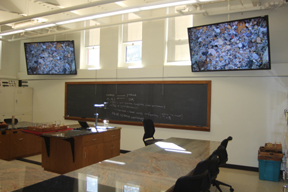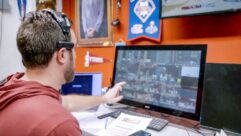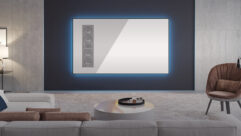
SVC Podcast – Show Notes – Show 143-2:
In this edition of the SVC Podcast, SVC Contributing Editor Bennett Liles wraps up his talk with Laboratory Coordinator John Wilson and Instructional Technology Systems Engineer E.J. Hudock of Lafayette College in Easton, Pennsylvania about their new collaborative geology laboratory. They provide details on the Extron matrix switcher, the video conveyance and how they worked with Vistacom to craft the BYOD friendly environment for the new classroom and lab.
Links of interest:
- Extron XTP matrix switcher used in the new geology lab
- Jonathan Fallos Cabinet Makers in Easton, PA
- Covid fiber HDMI cable used to extend the display video
Download Podcast Here:
https://s3.amazonaws.com/nb-svc/public/public/Vistacomm_Lafayette_Colleg…
From Sound & Video Contractor Magazine, this is the SVC Podcast with John Wilson and E.J. Hudock. Show notes for the podcast are available on the web site of Sound & Video Contractor Magazine at svconline.com.
The new collaborative geology lab at Lafayette College in Easton, Pennsylvania is a wonder to behold with big flat screen monitors, wireless connectivity and an Extron matrix switcher capable of putting any source on any display in the room. John Wilson and E.J. Hudock worked with Vistacom on the project and they’re back to finish up their story on it. That’s coming up next on the SVC Podcast.
Okay, John Wilson and E.J. Hudock from Lafayette College. E.J., you’re the Instructional Technology Systems Engineer and John is the Laboratory Coordinator. I know you two worked very closely on this and you worked with Vistacom on the installation. This must be great for the students to walk into a classroom like this especially if they had seen it the way it was before. You started pretty much with a bare room didn’t you?
John: Very true. We did take the old room which was antiquated, and make it very modern and exciting. The one nice thing about the room that we were really able to do was because it was a clean slate, we were able to bring in things and aspects that make the geology department tick. So instead of having boring black lab tables, we have 12 slabs of different types of rocks for the tabletops. So when the students walk in, the first thing they’re awed by is just the beauty of the classroom. And then when we bring out the technology it really shows them when the room can do. [Timestamp: 1:45]
Well, if you’re going to be talking about rocks you may as well have the décor match the discussion.
Absolutely.
So why did you decide on using the Extron TLP Pro touch panel? I believe that’s what you have for the user interface.
E.J.: Yeah, that’s correct. It’s actually a 10-inch Extron touch panel. We started in 2011 on a classroom upgrade project to retrofit all our existing smart classrooms. And part of that strategic plan was to switch over to the Extron control systems. So we’re in the process, we’re about 60 percent complete now in that process and we’re converting all our systems over to Extron control. [Timestamp: 2:22]
I know one of the more challenging things in the higher ed world for tech people to keep up with is the concept of “bring your own device” and that’s what everybody wants to do but it can be tricky to accommodate anything that comes in. How BYOD friendly is this room and what types of devices do the students bring in?
John: The room is very BYOD friendly, but it’s really broken down into two components. There’s the system BYOD and then there’s the microscope BYOD. So because the system is set up with HDMI ports, we can plug in just about anything with an HDMI out into the system, which is really nice if students want to plug in their laptops to be able to show what they’ve done, show their project, present a presentation, they can do that. On the other side with the microscopes, all the cameras are Wi-Fi enabled so we’re making a bunch of little wireless access points in the room where their laptops or their smart phones can connect via an app to the microscope and record live video, take digital still images, annotate the images, and record information of what it is they’re actually studying on the scope at that time. So it’s been very productive for the students that they can interface with whatever device they want to. [Timestamp: 3:41]
All right. So you don’t have a big mass of cables going everywhere and people trying to plug into the right place. Was any sort of RF coordination necessary to allow all of these wireless connections?
E.J.: No, we haven’t had any problems with the wireless, you might be surprised, because we’re essentially running 18 ad hoc wireless networks off of those microscopes and then there’s also the college wireless in the room as well. But so far, knock on granite, we haven’t had any issues. [Timestamp: 4:10]
You mentioned before in Part 1 how old this room was. Were any electrical upgrades necessary for the room to have this many sources and displays? Did you have to add a lot of AC outlets and things?
E.J.: Well, there was power, as I said, in the floor – in the concrete floor – but unfortunately it wasn’t in the place that we needed it to be for this new furniture layout. So again, we have a great relationship with our facilities department here at the college and they brought in their folks and they were able to move the electricity and add what was needed. We did have to run some extra data cables into the room to accommodate some of the systems, but nothing extraordinary, I guess. [Timestamp: 4:49]
Well, it’s always great when you can get that much done in-house. That varies widely between institutions. So how was the wiring done when it got to the furniture? Did you have to work with the cabinet maker in drilling holes and installing mounts and things?
John: All of that work was initially designed with the cabinet maker and Vistacom as we went through the process, such that the cabinet tops were pre-cubbied out. There were sets for high-voltage lines and a second cubby for the low-voltage HDMI lines that they’re isolated from each other and everything was set to the distances of where we wanted all the boxes to go. The cabinetmaker put all those things in exactly where they needed to be such that when the cabinets were in place, the electricians came in and they were able to run that wire because they knew exactly where it was going to go. [Timestamp: 5:38]
Okay. Well, you guys thought of everything, and when you got this all up and running there’s a point where you unleash the students and faculty on this and sort of stand back and see if there’s anything that you need to tweak. How was the response from the users on the new system?
E.J.: So it was pretty funny. I’ll jump in here. We were installing this room, as John mentioned, over the week before the semester started, so people are back on campus and there’s lots of buzz going around. And this was very well-choreographed. We had the cabinet bases come in, we had the electrician come in, we had Vistacom come in, and we had the granite tops laid down so everything was very choreographed. And as this process is going on over the span of that week, we have the faculty who are sticking their head in the room because they want to see what’s going on in here. So it was pretty interesting and the excitement level was pretty high before we actually let the folks into the room. As far as the learning curve piece of it, we learned a long time ago here that you want to keep a standard user interface on your touch panels. And so we’ve stuck to that throughout the last 15 years that we’ve been using touch panels, and so from a user standpoint the layout to the touch panel is very similar to any other room that they may have used on campus.
John: The only difference to the touch panel is there’s an additional programmed screen for the scope matrix. It’s set up such that we can turn Microscope 1 onto Monitor A, and Microscope 2 onto Monitor B, and anything in between. So that was the only new programming or the new touch panel interface that we actually had to learn, which really wasn’t that hard to learn because once you see the touch panel’s display, it’s arranged in the shape of the room. So if you see the student in that corner of the room, you can instantly know which microscope they’re on and everything just follows suit from there.
E.J.: And that’s the beauty of the Extron touch panel systems that we’re able to easily create those graphical representations of the room layout and make it very intuitive. And we never could have done this with a button system, I don’t think. [Timestamp: 7:41]
Yeah. I’ve installed both, and the hard button systems are certainly durable and easy to operate, but they can only go so far on upgradability. But uniformity is great when you have this many different users.
E.J.: Yep.
And the bottom line is that this is all about the students. Did they hit the ground running and can they now pretty much forget about the technology and just learn?
John: Absolutely. The students have embraced the room. Students that have learned in that room previously, who have taken classes in that room previously, come into the room now and they see the change from what it’s been. Where students that have never learned in that room before come into the room and it’s a brand new space for them that there’s no preconceived notions of what’s going to happen. And so they’re excited to learn in that room. But what’s great is that the technology is not only enhancing the way the students learn, but it’s enhancing the way we teach. We’ve already found a couple of different ways to utilize the system that we didn’t even think about when we were in the design stage. One example, when students were taking an exam last week, typically we have students looking through the microscope for part of the exam. Instead of having 18 microscopes around the room and every student having to look through the microscope, we had two stations and each station was ported up to the large monitors. That way, if a student who is very comfortable with using the microscope didn’t want to go and sit at the microscope, they could watch what’s on the monitor from another student using the microscope, and answer the questions to the exam without actually having to go and utilize the microscope. So we’re teaching differently. We’re teaching more effectively. Students are learning newer ways to look at things, and in general it’s saving time on both ends. For us to teach, it’s more time effective. And for students to learn, they’re grasping concepts much more quickly.
All right. Well, I know that it’s easy to throw too much technology at people and get bogged down in that but it sounds like you have just the right balance with just the right machinery and user interface. It has got to be saving the instructors lots of time in being able to keep up with their lesson plans and cover more ground. It’s been great hearing about it. John Wilson and E.J. Hudock from Lafayette College and the new collaborative geology lab there. I know it was fun when you guys got it all in and watched it all work.
John: We’re excited to see where the next 30 years of the room take us.
All right. Thanks, guys.
E.J.: All right. Thank you.
John: Thank you.
Thank you for being here with us for the SVC Podcast with John Wilson and E.J. Hudock. Show notes are available on the website of Sound & Video Contractor Magazine at svconline.com. Be back with us again for the next SVC Podcast.










